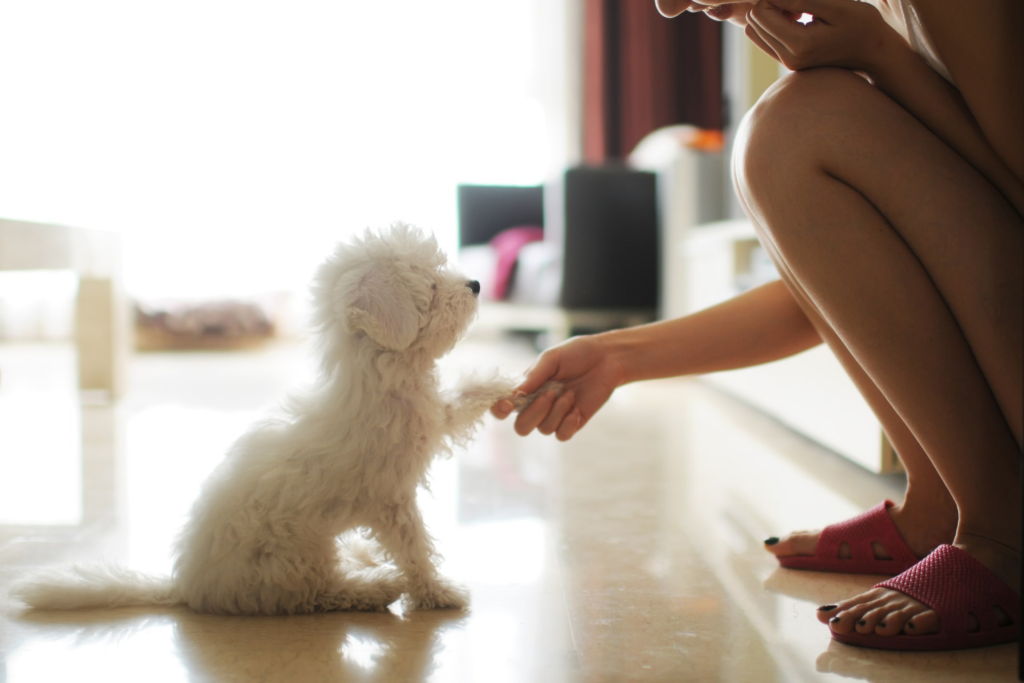Introducing a shy or fearful dog to a new situation can be stressful. These tips can help your dog feel comfortable.
Does your dog hide behind you at the park when other dogs approach? Does your pup bark in fear when new people visit your home? If so, you face a difficult challenge. Though you want to make sure that your pet is comfortable, you don’t want their nervous tendencies to prevent them from being exposed to new and exciting human and dog friends.
Here are 11 tips on how to introduce dogs to new people and other dogs:
Introducing a shy or fearful dog to new people should be “a slow process,” says Donna Rose Whitney, owner and head trainer at Tailwaggers Dog Training in Fairfield, Maine. Here are five tips on how to introduce dogs to new people in a comfortable, non-threatening way.
If you’re having a new person come over to your home, you should keep your dog confined until everyone is settled in and sitting down, says Dr. Jessica Gramlich, a veterinarian.
You should never allow the new person to approach, speak to or touch your dog until your pet makes the first move to signal that this type of contact is acceptable, says Whitney.
Without making eye contact with your dog, the new person should hold out dog treats or drop them on the floor nearby. During this process, the new person should stand sideways or in a crouching position.
Whitney points out that if you reward your dog for continuing to show fear or shyness, you will only delay their progress and increase the likelihood that they will continue to engage in this unwanted behavior.
If your dog finds the offered treats to be desirable, they will eventually feel confident enough to approach the new person, but it may take a while. You should never rush this process because that may only worsen your dog’s feelings of fear or shyness.
“The critical socialization period for puppies is between 3 and 12 weeks of age.”
You can help your dog feel comfortable with meeting other animals by starting out with “positive reinforcement, counter-conditioning and training with a known friendly, calm dog,” says Gramlich. Here are six tips on how to properly introduce your dog to a potential canine friend.
Make sure that you begin this process in a controlled environment that has little to stimulate or distract your dog.
According to Whitney and Gramlich, you should start by introducing your pet to a confident, well-socialized dog, as this will help you learn how to handle these types of introductions.
When making this initial introduction, make sure that both dogs are properly leashed. Keep your distance from the other dog and their handler at first, and reward your dog for calm behavior. Then, approach the new dog slowly. When the dogs eventually meet up, you can allow them to sniff and circle around each other. Afterward, you should walk away with your dog.
Throughout this introduction process, you should reward your dog when they display confident behavior, as this will encourage a positive association with meeting new dogs.
According to Whitney, using tight leashes or pulling dogs apart can cause a negative reaction in your pet.
Depending on just how shy or fearful your dog is, you may have to repeat this process several times for them to feel truly confident around other dogs. Once they are able to build up this confidence, you both will feel more comfortable and relaxed on your outings.
It’s difficult to know what causes one dog to feel more fearful of certain dogs or people than others, but both Whitney and Gramlich state that early, positive socialization is key for confident, well-behaved pets. “The critical socialization period for puppies is between 3 and 12 weeks of age,” says Gramlich.
“It is important during this critical socialization period to expose your puppy to people (children, males and females, people in uniform and men with beards and hats), other dogs (friendly, big and small), other animals (cats and pocket pets, if you have them) and environments (grass, concrete and water) in a positive way. When puppies have adverse experiences, they may develop a phobia later on in life that can be very difficult to manage.”
By following these tips and best practices, you can help your dog to overcome their fear and live a happy, confident life.
How to stop cats from scratching furniture, according to experts
What to do if a family doesn’t pay you? Experts weigh in
Like what you’re reading?
Join Care for FREE
Email is required.
Click ‘Next’ to start an account and get tips, tricks and trending stories.
Already Registered
The email address you entered is already registered. Would you like to log in?
Almost done!
Join Care for FREE
Create a free account to access our nation wide network of background checked caregivers.
First name is required.
Last name is required.
Zip code is required.
We’re sorry, your request could not be processed at this time. Please click here to try again.
By clicking “Join now,” you agree to our Terms of Use and Privacy Policy.
Welcome to Care!
You’re on your way to finding someone your family will love.
About Care.com
Get help
Popular topics
Discover
Care.com does not employ any caregiver and is not responsible for the conduct of any user of our site. All information in member profiles, job posts, applications, and messages is created by users of our site and not generated or verified by Care.com. You need to do your own diligence to ensure the job or caregiver you choose is appropriate for your needs and complies with applicable laws.
Care.com® HomePay℠ is a service provided by Breedlove and Associates, LLC, a Care.com company.
Care.com is a registered service mark of Care.com, Inc. ©2007-2023 Care.com, Inc. All rights reserved.

